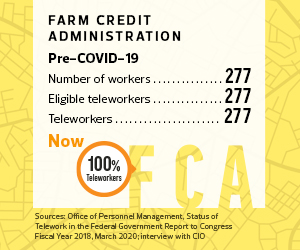FEDTECH: What proportion of your agency usually teleworks?
GOLLEY: A large portion of our staff does audits, and they travel a lot. It’s not necessarily telework per se, but it’s a mobile workforce. We also have a large portion of people who will telework one day or so per pay period. A large number of people were mobile-ready. But what we didn’t know was if we could support everybody teleworking simultaneously. In our previous time, we might have had half the agency at any one time working remotely, at its peak. So to go to 100 percent of the staff teleworking was a test. We passed the test.
We thought bandwidth might be an issue, and we suspected a limit on VPN connections and management. In fact, there was a limit. When we reached 255 — 255 is, of course, a magic binary number — we had to change our addressing configuration to support more than 255.
FEDTECH: What IT situations arose that you did not expect? How did you handle them?
GOLLEY: Everybody immediately wanted to videoconference. We had an internal video tool, Skype for Business, and then people started using their own Zoom. We made a decision to go with Webex. We worked with Cisco to quickly purchase a video tool and enable it for everyone to access quickly. A couple of other things we had to do — for instance, we had paper processes, and staffers were happy with the paper processes, but as soon as everybody was at home, it became a requirement that we automate and digitize those processes, which we were able to do quickly. Specifically, it was package routing. There might be a situation where a policy would have to be reviewed and signed by the COO or chairman. Typically, we’d have a cover sheet put on the package as it was routed from one director to another, and everybody would review it and sign it. We created a workflow that simulated that experience with a digital process, so you could attach a file to the workflow and then pass the object from person to person and have the same experience that you would have manually.
MORE FROM FEDTECH: Learn more about the tech your agency will need to continue teleworking smoothly.
FEDTECH: What was the transition to Webex like?
GOLLEY: It took a little bit of time, but not much — maybe a week. We had a user support team that was on call anytime, day or night, to help with any problems. That team was already in place; it was our standard user support team. But the thing that was a surprise is that we moved them all to working from home. I was really impressed with how focused the team was working from home. They’d been a good team, working in the office, but it was limited to the hours during the day. Working from home, they stepped up, they learned the new technologies quickly and met needs as people had them. We had our first virtual board meeting using Webex in April. Everyone, including the chairman, participated in that meeting from home using Webex. To prepare, we did a couple of practice sessions where we got everybody to do it a couple of times in practice. So by the time it happened for real, it was a pretty seamless and enjoyable experience. We had another big meeting, 172 people participating in a Webex all-hands meeting. For the most part, we had no problems. But there were a few people who had local or in-house network issues, and that disrupts everybody.









.png)



